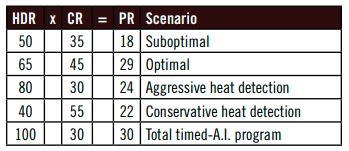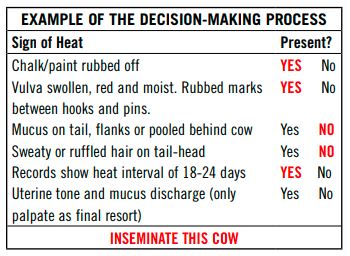To breed or not to breed? That is the question all
technicians ask when standing behind a cow that
appears to be in heat, but is not showing enough signs of
heat to make a breeding decision.
When using visual observation for heat detection, a cow
is determined to be in standing heat when she has been
observed standing for mounting by other cows without
trying to avoid it. Using the tail-chalking system, the
equivalent condition to a standing heat is finding tail chalk or paint rubbed away due to mounting activity. In
addition, confirmation that the cow is truly in heat is
facilitated by several secondary signs of heat and analysis
of records to indicate a correct between-heat interval.
Regardless of the heat detection program implemented
on the farm, the goal is to achieve an approximate 65
percent heat detection rate (HDR). The remaining cows are
made up of a combination of undiagnosed heats and/or
anestrus cows.
MISDIAGNOSED HEATS
Misdiagnosed heats mainly occur due to an aggressive
attitude towards heat detection. Pregnant cows are
sometimes bred by mistake either because of an
aggressive heat detection or because some pregnant cows
do show some signs of heat.
QUESTIONABLE HEATS
A questionable heat is the result of a cow that was not
seen standing to be mounted and/or is not showing enough
secondary signs of heat. Making the decision to breed cows
with questionable heat is the greatest challenge for new
technicians. This is when most heat detection errors are
made. At least 25 percent of detected heats presented are
classified as questionable. A questionable heat could be
one that at first glance does not convince you that the cow
should be bred. These cows will require closer observation, a review of records and may need to be palpated to analyze
the uterine tone and/or mucus discharge. This investigation
will help you make a decision on about half of the
questionable heats. There will still be a number of
questionable heats for which you just can’t find enough
reasons to breed, even though some may truly be in heat.
Records should be routinely used in the decision-making
process to breed or not to breed cows showing questionable
heats. Information is the most valuable tool of any heat
detection program. Records usually provide the necessary
information to make the right breeding decision.
Records should always be in the hands of the
technicians and should contain the following information:
• Identification of every cow and the pen she is in
• Reproductive status: open, bred, pregnant or cull
• Days in milk: Is she eligible to be bred?
• Number of times bred
• Days since last heat or A.I.
• Interval between heats prior to this one
• Breeding code (trigger) of last A.I.
If there is still doubt about whether or not to breed after
analyzing the records and having searched for secondary
signs of heat, cows can be palpated for uterine tone and
mucus as a last resort. Never abuse this practice.
Experienced technicians develop a system of observing
the cows for the detection of heats. Most technicians feel
confident in their heat detection efficiency using their own
system. Regardless of “what the cows tell you,” there
should be a follow-up with records to confirm that this
estrus detection system really works. Most importantly, the
technician must be willing to adapt and modify this system
if it proves to be inefficient. The approach and attitude
towards heat detection can influence the number of
resulting pregnancies. Aggressive heat detection may be
an asset or detriment to a breeding program.
As a result of aggressive heat detection, farms will
usually have a high HDR in combination with a low
conception rate (CR). Other indicators of being too
aggressive with heat detection are a high number of
services per conception, too many cows being bred off-cycle and cows found pregnant to an earlier breeding when
checked for pregnancy.
On the other hand, being overly cautious will result in
missed heats, yielding a low HDR but a high CR. Indicators
of poor HDR include: long days open, insufficient number of
pregnant cows in the herd, extended days in milk at first
service, a very high percent of cows submitted to estrus
synchronization, among others.

The example chart describes the relationship between
HDR and CR, and its effect on pregnancy rate (PR). Note
the various scenarios and the impact on the PR.
Every farm should have a protocol in place that is used
to decide if a cow showing a questionable heat should be
bred. Below is an example:
BREED
1. She received prostaglandin within the last
two to six days.
2. The interval from her previous breeding to now is
between 18 and 24 days, and she has two or more
secondary signs of heat.
3. She has not been bred before and is showing two or
more secondary signs of heat.
DO NOT BREED
1. She is showing only one secondary sign of heat.
2. She is still inside the voluntary waiting period.
3. The records indicate that she is pregnant.

This example should lead to the development of your own
decision-making program. This process is illustrated in the
following example. Keep in mind that what you are trying to develop is a guide that can be useful in most cases.
TAKE HOME MESSAGE
• The HDR and CR both influence pregnancy rate; it is
important to find a balance of these two to generate
a greater number of pregnancies.
• Because it is so difficult to decide whether or not to
breed cows showing questionable heats, technicians
should have a protocol in place for such a
circumstance.
• A profound understanding of secondary signs of heat
is a must when using the tail-chalking system
because these signs are necessary to confirm estrus
when a cow is showing a questionable heat.
• Consistently monitor records to evaluate the
aggressiveness of heat detection and make changes
whenever a less than optimal level is detected.
PDF IN ENGLISH
PDF IN SPANISH